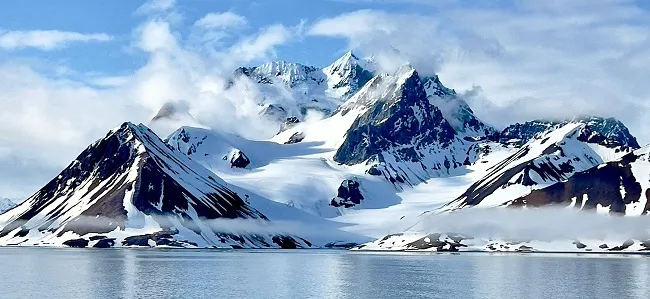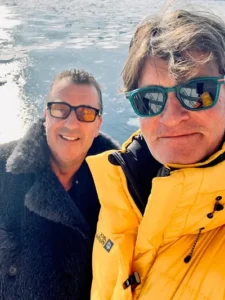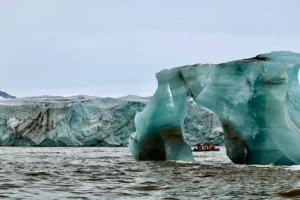Polar Alert: the Arctic is vanishing and that is everyone’s problem

The Arctic is vanishing. It is warming faster than anywhere else on the planet and the sea ice in the Arctic Ocean has been decreasing at an alarming rate for decades. There has been an overall decline of about 60% since 1900, most of it since 1980.
And what happens in the Arctic doesn’t stay in the Arctic. It has far-reaching effects because the Arctic is the world’s refrigerator: it helps regulate Earth’s climate, weather patterns and ocean circulations. Sea ice loss is not just a threat to the entire Arctic ecosystem, it is also a major global tipping point for irreversible climate change.
 To see for himself, Sovereign Chairman Howard Bilton joined filmmaker Craig Leeson on the ‘Bears, Ice, Glaciers, Arctic Climate Expedition’ (BIG ACE) 2025. Craig, who has directed and produced several films for the Sovereign Art Foundation, is also an explorer and environmentalist who directed ‘A Plastic Ocean’ an award-winning film documenting the global effects of plastic pollution and “The Last Glacier” the subject of which is self-explanatory.
To see for himself, Sovereign Chairman Howard Bilton joined filmmaker Craig Leeson on the ‘Bears, Ice, Glaciers, Arctic Climate Expedition’ (BIG ACE) 2025. Craig, who has directed and produced several films for the Sovereign Art Foundation, is also an explorer and environmentalist who directed ‘A Plastic Ocean’ an award-winning film documenting the global effects of plastic pollution and “The Last Glacier” the subject of which is self-explanatory.
BIG ACE is an initiative by Singaporean marine photographer and environmentalist Michael Aw, the founder of Ocean Geographic, to take 110 ‘changemakers’ – including scientists, artists, musicians, educators and, in Howard’s case, winemakers – to the High Arctic aboard a purpose-built expedition ship, the MV Sylvia Earle. Each participant was asked to contribute their specialised expertise for a collective cause and then to advocate for Arctic preservation and climate action.
Fittingly, pioneering marine biologist, oceanographer, explorer and conservationist Dr. Sylvia Earle herself was on board the vessel named in her honour to lead the expedition. A living legend who celebrated her 90th birthday on board, Dr Earle is affectionately known as ‘Her Deepness’ after logging over 7,000 hours underwater, using scuba gear and submersibles to document marine life and advocate for ocean protection.
The expedition embarked from Longyearbyen, Svalbard, and navigated northward to go beyond 80°N – the ‘top of the world’ – in pursuit of the remaining Arctic ice shelf and circling around Austfonna, one of the largest glaciers on the planet. The aim was to encounter and observe a diverse array of Arctic wildlife, including polar bears, walruses, puffins and arctic foxes, while assessing the polar ecosystem and taking measurements of the ice.
Howard writes:
“Before this trip I was aware to some extent of the concerns about climate change. We have already seen what it is doing to the wine industry. Climate change is increasingly affecting grape yield, composition and wine quality in the traditional wine regions of Europe and America and is driving the emergence of new wine regions like the south of the UK. One of the leading and largest wine growers in Portugal, where I live, has even developed a 30 year plan to switch to growing hemp as they believe it will be too hot to grow grapes .
“So, when Craig mentioned the BIG ACE arctic expedition, I realised it was a unique opportunity to go and see for myself what is happening.
“We first gathered in Oslo for a day of presentations before flying to Longyearbjen on Svalbard to board the MV Sylvia Earle. We then sailed 500 miles further north into what should have been sheet ice, but as we travelled through the fjords over the first days of the expedition the sun was shining on ice-free waters. The lowest ever sea ice maximum was recorded in April this year – not just a mark of the impact of climate change on the Arctic ecosystem but a sobering reminder that this crisis is unfolding in real time and much faster than I had previously appreciated .
“The Greenland Ice Sheet is considered to be at a major irreversible global tipping point. With less ice to reflect sunlight, more heat is absorbed by the ocean, contributing to changes in atmospheric and oceanic patterns, as well as to an increase in the extreme weather events that we have all been experiencing. Scientists estimate that the threshold for slow but inevitable disintegration of the ice sheet lies somewhere between 1.5 and 2.2 degrees of global warming.
 “With current commitments to reduce greenhouse gases, we are on track for 2.3 degrees of warming by 2100. This would be sufficient to melt large parts of Greenland and West Antarctica, leading to massive sea-level rises. The thawing permafrost will also release additional greenhouse gases into the atmosphere. Once this process begins, it will continue for hundreds of years, leaving future generations to deal with its effects. That’s not a legacy that anyone should be proud of.
“With current commitments to reduce greenhouse gases, we are on track for 2.3 degrees of warming by 2100. This would be sufficient to melt large parts of Greenland and West Antarctica, leading to massive sea-level rises. The thawing permafrost will also release additional greenhouse gases into the atmosphere. Once this process begins, it will continue for hundreds of years, leaving future generations to deal with its effects. That’s not a legacy that anyone should be proud of.
“Life on board began early with breakfast at 6.15 but, as the sun never sets in the Arctic summer, getting to sleep was more of a problem than getting up. Breakfast was followed by a briefing on what everyone was going to be doing during the day – parties going out in kayaks or rigid inflatable boats to monitor wildlife or diving for samples – and points of interest to look out for. As a ‘non-specialist’, I was generally out in the kayaks unless called into action as Craig’s assistant cameraman.
“We were privileged to see polar bears on the ice, herds of walruses – I cannot describe the smell but they clearly do not put much emphasis on personal hygiene – colonies of puffins and glaciers. We were always careful to maintain a distance because new regulations implemented this year require tourists to maintain a minimum distance of 500 meters from polar bears from March to June to prevent disturbance to the animals. It was notable, and worrying, that we saw very few seals, dolphins and whales.
“Landings onto the ice sheet itself were kept to a minimum due the need to carry weapons as a defence against the lethal threat of polar bears. The bears are dangerous, strong and curious animals with no natural predators. They are also one of the very few species that view humans as potential prey and may hunt them for food.
“We would return for lunch and then head out again in the afternoon. In the evening there were lectures from the multitude of experts that were on board, followed by supper. As the resident winemaker, my specialist contribution was to bring a selection of my Howard’s Folly wines from Portugal and we held a wine tasting as well showing one of Craig’s Sovereign Art Foundation films.
“I also opened a bottle at the most northerly point of the expedition, about 82 degrees north. This may well be a record for polar wine consumption but is also a devastating measure of loss because it should have been unreachable due to thick sea ice. Now, it is open water.
“I had rather anticipated a diet of seafood aboard the vessel, but no fish or shellfish were served during the voyage at the specific request of Dr Earle who actively campaigns for a ban on industrial fishing in the high seas and for a drastic reduction in commercial fishing.
“In her work she has seen the devastating effects of overfishing on the marine ecosystem, the devastation caused by bottom trawling on the ocean floor, and the lethal impact on marine wildlife of the vast quantities of fishing gear – nets, pots, lines and hooks – that are lost at sea every year. She has not eaten seafood for over four decades despite being tied to the oceans.
“Dr Earle believes that wild fish have value within the natural ecosystem that outweighs their value as food and advocates for sustainable seafood alternatives to protect the ocean’s ecosystems, and the well-being of the planet. She is also president of Mission Blue, an organisation that aims to establish marine protected areas (MPA) around the world. Her example has certainly changed my attitude to seafood.
“I came away from my BIG ACE experience having witnessed the impacts of climate change first-hand. We should all be doing all we can to reduce our carbon footprint in every way. What is happening in the polar regions and in the rainforests are what climate scientists refer to as ‘tipping points’: tipping over these thresholds will set in motion self-perpetuating processes that will push the Earth’s climate system into irreversible change. To further complicate things, one tipping point can trigger another.
 “At present we are all just sleepwalking into disaster because no one wants to take responsibility. Everyone – governments, businesses and consumers – just leaves it someone else because the danger doesn’t seem immediate enough. But it is a planetary emergency and it is only by convincing enough people of all ages and backgrounds that the threat isn’t cyclical, it is irrevocable, that we are likely to see the real and drastic action that we need.
“At present we are all just sleepwalking into disaster because no one wants to take responsibility. Everyone – governments, businesses and consumers – just leaves it someone else because the danger doesn’t seem immediate enough. But it is a planetary emergency and it is only by convincing enough people of all ages and backgrounds that the threat isn’t cyclical, it is irrevocable, that we are likely to see the real and drastic action that we need.
“That is why the BIG ACE expedition was comprised of such diverse individuals – spanning different cultures, ages, talents and disciplines. Not just scientists and oceanographers, but artists, filmmakers, writers, musicians, educationalists and, yes, even winemakers. The aim is to engage a wide audience across various mediums, instigating meaningful conversations and spurring action to safeguard the planet for future generations.
“To that end all those privileged to be a part of the expedition pledged to become BIG ACE Ambassadors and to advocate for full protection of the Arctic from extraction, to foster a collective appreciation of our planet’s fragility and beauty and to promote the conservation and protection of the Arctic wilderness. It is our role to amplify the voices of nature and inspire a global movement toward environmental stewardship and sustainable living. We must put the long-term health of the planet ahead of short term economic and lifestyle considerations if we are to have an habitable planet in the future.
“The MV Sylvia Earle sailed under an ‘Explorers Club’ expedition flag, which is going to be returned to the club in New York on 21 September during the New York Climate Week. By this time, BIG ACE aims to have secured at least 10,000 signatures for its online petition to ‘Protect the Arctic Ocean – from surface to sea floor”.
“The petition calls on Global Leaders to:
- Fully protect the Central Arctic Ocean and last Ice Areas
- Elevate Polar Bear protection to CITES Appendix I
- Slash greenhouse gas emissions immediately
- Invest in science, education and indigenous leadership
“Finally, it calls on the world to act together with love, speed, ambition, unity and hope. Delay is not an option. There is no more time for debate. We must let our action be the story future generations remember, not our excuses.
“So, I very much hope that will join me in signing the petition. The planet needs your voice now more than ever. Please treat this as if your future – and the future of your loved ones – depends on it. Because it does. And please share the resolution often. Share it everywhere. Let’s make this global.”
THE ARCTIC CANNOT WAIT. WE CANNOT FAIL.
This is our line on the ice.
Sign and Share the Petition: https://tinyurl.com/BIGACEPETITION
Read the Resolution: https://tinyurl.com/BIGACEARCTICRESOLUTIONF
